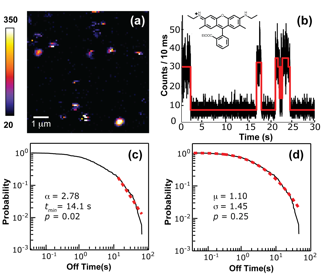58th Annual Report on Research 2013 Under Sponsorship of the ACS Petroleum Research Fund
Reports: UNI650873-UNI6: Probing Heterogeneous Electron Transfer Processes in Next-Generation Photovoltaics Using Single-Molecule Spectroscopy
Kristin L. Wustholz, PhD, College of William and Mary
Research Progress
During the second year of support from the ACS Petroleum Research Fund, my students and I have pursued two strategies toward the goal of understanding electron transfer (ET) processes in next-generation solar cells: (1) characterizing heterogeneous ET processes in dye-sensitized solar cells (DSSCs) using single-molecule spectroscopy and robust statistical analyses, and (2) synthesizing model plasmon-enhanced DSSCs and probing molecular photophysics near metal interfaces.
In the first approach, single-molecule blinking is used to characterize the distributions of ET dynamics of dye sensitizers on TiO2. Blinking is characterized as random switching between "on" and "off" periods under continuous laser illumination due to the population and depopulation of emissive and non-emissive states. To characterize the ET kinetics in DSSCs, we measured the blinking dynamics of >100 rhodamine B (RB) and rhodamine 6G (R6G) molecules on glass and TiO2 nanoparticle substrates. Blinking dynamics are quantified by constructing cumulative distribution functions of emissive ("on") and non-emissive ("off") events. Maximum likelihood estimation (MLE) methods and quantitative goodness-of-fit tests based on the Kolmogorov-Smirnov (KS) statistic are used to establish the best fit to the photophysical data. The on-time distributions for R6G and RB on TiO2 are fit by power laws, but only for emissive durations that last longer than ~ 0.7 s. Furthermore, large variations in the power-law exponents are observed when using least-squares fitting as compared to the combined MLE and KS-test approach. The off-time distributions for molecules on TiO2 and glass are not consistent with power laws and are instead well represented by log-normal distributions. Figure 1 presents the probability distributions of non-emissive events for R6G on TiO2 – showing the shortcomings of the conventional power-law fit. The on-time and off-time distributions are sensitive to the substrate as well as the chromophore. To understand the origin of these power-law and log-normal distributions, we modeled single-molecule blinking dynamics using Monte Carlo simulations based on a three-level system with the rate constants for population and depopulation of the non-emissive state being log-normally distributed. In this framework, the rate constants for forward and back ET are log-normally distributed, consistent with a Gaussian distribution of activation energies. These results demonstrate that ET kinetics on dye-sensitized TiO2 are complex and not always consistent with multi-exponential or power-law distributions as previously believed. Our observations suggest that these variations relate to the distribution in ET rates among various sites on the TiO2 nanoparticle film, though experimental and modeling studies are underway to test this hypothesis.
Figure 1. (a) Fluorescence image from 10-9 M R6G spun coat on TiO2; (b) Blinking dynamics of a single R6G molecule on TiO2; (c) back ET dynamics are not well represented by a power law (red dashed line) since the goodness-of-fit value is insignificant (p = 0.02); (d) back ET dynamics are instead consistent with a log-normal distribution (red dashed line).
Another strategy to improve DSSC efficiency is to reduce device thickness while maintaining optical absorption via the introduction of plasmonic nanostructures. To probe the distance dependence of fluorescence enhancement near individual metal nanoparticles, we devised a reliable synthesis for silica-coated nanoparticles (SCNPs) with varying shell thicknesses (~8 nm to 75 nm). The resulting SCNPs are then coated with rhodamine fluorophores using spin coating in order to probe the extent of fluorescence enhancement in proximity to the SCNPs. In year two we developed a reliable strategy to quantify fluorescence enhancement. Correlated structural and optical measurements of individual dye-coated SCNPs are now underway to establish the role of nanoparticle structure and optical properties in FL enhancement.
Career Development
Financial support during year 2 has been used to support 5 undergraduate students at the College of William and Mary. Receiving the ACS PRF UNI grant has had a profound impact on my career as well as the intellectual development of a total of 10 undergraduate researchers since 2010. In addition to supporting basic research and purchasing supplies, this grant made possible paid summer research opportunities for several students as well as travel support to present our findings to the photochemistry and solar energy communities. As a result of these combined efforts, we recently submitted a manuscript for publication in J. Phys. Chem. C. The first students on ACS PRF grant support to graduate from my group (Garakyaraghi '13, Blake-Hedges '13) are now enrolled in Ph.D. programs in chemistry.
Copyright © 2014 American Chemical Society












